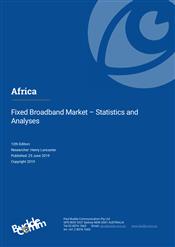2019 Africa - Fixed Broadband Market - Statistics and Analyses

Last updated: 25 Jun 2019 Update History
Report Status: Archived
Report Pages: 541
Analyst: Henry Lancaster
Publication Overview
Report highlights:
- Key developments in the internet and broadband sectors of African countries;
- Profiles of major Internet Service Providers (ISPs);
- Overview of DSL services and WiMAX networks, with pricing comparisons;
- Updates on CDMA-2000 network rollouts;
- Market developments relating to international and national infrastructure projects;
- FttP developments;
- Regulatory policies affecting investment strategies
- Africa Telecoms Maturity Index.
The countries covered in this report include: Algeria, Angola, Benin, Botswana, Burkina Faso, Burundi, Cameroon, Chad, Cote d’Ivoire, Democratic Republic of Congo, Djibouti, Egypt, Eritrea, Ethiopia, Gabon, Gambia, Ghana, Guinea, Kenya, Lesotho, Liberia, Libya, Madagascar, Malawi, Mali, Mauritania, Mauritius, Morocco, Mozambique, Namibia, Niger, Nigeria, Rwanda, Senegal, Sierra Leone, South Africa, South Sudan, Sudan, Swaziland, Tanzania, Tunisia, Uganda, Zambia, Zimbabwe.
Researcher:- Henry Lancaster
Current publication date:- June 2019 (12th Edition)
Executive Summary
African broadband markets being strengthened with upgrades to national telecom networks
The development of the fixed-line broadband market in Africa has long been stymied by the lack of fixed-line infrastructure in rural and semi-rural regions, as well as by the poor quality of networks in those urban areas where they are concentrated. As a result, mobile networks provide the principal platform for voice and data connectivity. Depending on the market, between 90% and 98% of all internet connections are via mobile networks and thus governments and regulators alike are concentrating on this platform to deliver on their broadband targets.
However, progress is being made to increase backhaul capacity on both the international and national levels. This backhaul is being used to improve fixed-line telecoms as well as to support growing mobile data traffic. New submarine cables are being built to provide direct links to southern Europe and Brazil (the latter with onward connectivity to the US east coast).
Many countries are tapping into existing submarine or terrestrial cables to provide improved links to underserved regions. In Nigeria, for example, the newly commissioned Glo-2 cable will connect Lagos to cities on the south coast with extensions to the existing terrestrial backbone network, while two branching lines will provide onward connectivity to Cameroon and Equatorial Guinea. For its part, the government is committed to building an additional 18,000km of fibre in a bid to extend the reach of broadband from urban areas to rural parts of the country. Although the national network at the start of the project ran to about 38,000km the telecom regulator perceives that the country needs at least 120,000km of fibre to provide national coverage.
These projects are supported by sympathetic regulatory regimes as well as by governments which understand the key functions of broadband connectivity for economic growth. Through this awareness countries are placing greater focus on their fibre-based national broadband plans. These efforts are supplemented by small-scale fibre operators which are expanding their investments beyond the wealthy suburbs and business districts.
These efforts aimed at increasing the use of ICTs and developing broadband penetration are crucial to augmenting economic productivity and GDP growth, and further driving a range of benefits based on enhanced social inclusion.
Henry Lancaster
June 2019
Related Reports
- Africa - Fixed Broadband Market - Statistics and Analyses
- 2019 Africa - Mobile Network Operators and MVNOs
- Ethiopia - Telecoms, Mobile and Broadband - Statistics and Analyses
- Morocco - Telecoms, Mobile and Broadband - Statistics and Analyses
- Namibia - Telecoms, Mobile and Broadband - Statistics and Analyses
- Madagascar - Telecoms, Mobile and Broadband - Statistics and Analyses
- Benin - Telecoms, Mobile and Broadband - Statistics and Analyses
- Cameroon - Telecoms, Mobile and Broadband - Statistics and Analyses
- Eritrea - Telecoms, Mobile and Broadband - Statistics and Analyses
Share this Report
TMT Intelligence
A platform to scale your intelligence tasks
Monitor critical insights with our AI-powered Market Intelligence Platform gathering and analyzing intelligence in real time. With AI trained to spot emerging trends and detect new strategic opportunities, our clients use TMT Intelligence to accelerate their growth.
If you want to know more about it, please see:
Research Methodology
BuddeComm's strategic business reports contain a combination of both primary and secondary research statistics, analyses written by our senior analysts supported by a network of experts, industry contacts and researchers from around the world as well as our own scenario forecasts.
For more details, please see:
More than 4,000 customers from 140 countries utilise BuddeComm Research
Are you interested in BuddeComm's Custom Research Service?
Hot Topics
News & Views
Have the latest telecommunications industry news delivered to your inbox by subscribing to BuddeComm's weekly newsletter.